2021 Ducati Multistrada V4 Review - First Ride

Truly an all-terrain vehicle
I’ve been fortunate enough to attend the last two Ducati Multistrada press launches for MO. In late 2017, I was in Gran Canaria putting the then-new Multistrada 1260 through an endless series of switchbacks up the side of a volcano. I came away thoroughly impressed with the chassis and quickness of that big adventure/sport/touring bike. In addition to the motorcycle’s natural ability, the electronics suite allowed the ride to be tailored to fit a large swath of rider preferences. From the throttle response to the suspension – all was easily adjusted with the handlebar’s switchgear. It was the swiss army knife of motorcycles, I thought.
2021 Ducati Multistrada V4
| Engine | 19.0/20 |
| Suspension/Handling | 14.5/15 |
| Transmission/Clutch | 9.5/10 |
| Brakes | 9.5/10 |
| Instruments/Controls | 5.0/5 |
| Ergonomics/Comfort | 9.5/10 |
| Appearance/Quality | 9.75/10 |
| Desirability | 9.5/10 |
| Value | 8.5/10 |
| Overall Score | 94.75/100 |
Fast forward to the sound of an Italian V4 blasting up a sandy cactus-lined trail ascending into the mountains in the California desert. As it had with the 1260, Ducati once again promises major upgrades in terms of its “adventouring” motorcycle’s power plant and electronics. A Multi even better suited to a wider range of stradas. The Italian marque has said its pillars for the new Multi consist of on-road enjoyment, long-distance comfort, off-road capability, and premium content and technology. Sounds good in theory, right?
Ducati has broken from tradition in the past few years, replacing its long-standing V-Twin flagship power plant with a young, studly, raucous V4 platform. We first saw the V4 Stradale usurp the V-Twin of the Panigale sportbike in 2018 and last year, Ducati bestowed the latest Streetfighter onto the motorcycling public also equipped with a re-tuned version of the Stradale V4. After Troy’s first ride on the machine, three words came to mind: Raw. Brutal. Mind-blowing. Although that sounds enticing in a monstrous naked bike, those probably aren’t the words you want to hear describing the motorcycle you plan on riding to work, on long trips, or off-road. Enter the V4 Granturismo.
V4 Granturismo
Supplanting the V4 Stradale into the Multistrada simply would not work for the intended purpose(s) of the bike. Changes had to be made to mold the MotoGP-inspired engine platform into a touring-friendly machine. The new V4 Granturismo boasts a slightly larger 1158cc displacement thanks to its 2mm larger bores. Stroke and compression ratio remains the same at 53.5mm and 14:1. The V4 Granturismo is said to weigh 147 lbs, making it a touch over two pounds lighter than the outgoing Testastretta DVT V2 and five pounds heavier than the Stradale V4. It’s also 3.3 inches shorter in length and 3.7 inches shorter in height while width has increased just 0.8 inches compared to the Multi 1260’s engine. Ducati tells us the Granturismo V4 is cranking out 170 Italian stallions at 10,500 rpm and 92.2 lb-ft at 8750.
A further break with tradition – and a major talking/selling point of the new engine – is the switch to a spring-actuated valve train which allowed Ducati to boost time between service intervals to 37,282 miles (60,000 km) – more than double that of the previous Testastretta mill. An impressive feat for any manufacturer, and also a statement from one that has previously been chastised for short service intervals that add up to spendy labor bills for riders putting down serious miles. Ducati made sure to point out to us that the Multistrada V4’s service intervals would allow one to circumnavigate the world 1.5 times before the valves required a check.
Ducati says its Desmodromic valve trains still have a place in its sporting motorcycles – including MotoGP – but for the Multistrada, it wanted to deliver its customers the most efficient and practical system it could. Desmo will live on at Ducati where it makes sense, but there have been vast advances in metallurgy over the years, and with a motor redlining at 11,500 rpm, springs will do just fine. Not to mention everyone else has been making do with springs for decades. The steel valves themselves, the finger-type rockers, and less aggressive cam profiles all work to put less stress on the components and are designed to deliver smooth power.
The Granturismo V4 also shares the counter-rotating crankshaft from the other V4s, which acts as a gyroscopic counterbalance to the force of the wheels, giving the motorcycle a very balanced, planted feeling while at the same time acting as a sort of natural wheelie mitigation. Don’t worry though, those 92.2 lb-ft will still pull dank nooners if that’s your thing.
A further break from tradition continues with the new Multistrada V4’s monocoque aluminum frame. It is, however, bolted to a nice bright Ducati red steel trellis subframe. A new double-sided swingarm is also used.
Getting Down And Dirty
The way things panned out, I would begin my time on the V4-powered 536(+)-pound motorcycle in the dirt. Cool. If I were to choose, I might have liked to get acquainted over a nice set of curves before diving into the dirt with the beautiful, but intimidating, Italian temptress. Of course, as our loyal readers know, I’m not one to shy away from time out in the bush, so off we went to find out if the 2021 Multistrada V4 had become any more competent than the last time I rode the V-Twin version in the dirt.
The last time was the 1260 S that we had around during our Big Bore ADV shootout in 2018. During that short stint off-road, the Multi’s 17-inch front wheel proved to be less than ideal in soft terrain as its relatively small size and girth caused the front end to push constantly. Cast wheels can also be nerve-racking when trying to carry any sort of speed in rocky terrain. Stick to graded, or better yet paved roads though, and the Multistrada has always been the leading sporty ADV bike to be reckoned with. Simply put, the Multistrada 1260 is a great motorcycle, but as it comes off the showroom floor, most other large ADVs were better equipped to deal with off-road surfaces.
Back to the cactus-lined trail. I thought to myself, “It’s a good thing this bike has handguards,” Memories flashed through my head of riding the 1260 off-road with its ponderous front wheel. I was sure that this motorcycle’s front wheel would betray me at any moment. Surprisingly, it wasn’t difficult at all to keep the big bike tracking straight. It was then that I remembered I was rolling on a 19-inch spoked tubeless front wheel which really made a vast improvement in the Multistrada’s stability off-road. The rear wheel is also slimmer, now shod with 170/60 ZR 17 rubber (down from 190) – Pirelli Scorpion Rallies to be exact for this portion of our test.
I had also prepared myself expecting the motor to be a handful. Again, not the case. After our short transport section of pavement – taken at a pace that relieved our 50/50 tires of chicken strips – I switched the Multistrada from Sport into Enduro, which limits power to a measly 100 horses and delivers softer throttle response. Each of the four ride modes have specific settings for engine braking, traction control, ABS, wheelie control, front and rear suspension damping (on the S and S Sport models equipped with Ducati’s electronic Skyhook suspension), and preload. What’s great about all of that is that each parameter can be adjusted. Say you like the sharp throttle response of Sport mode, you can go into Sport through the settings menu and dial everything in to make it a sporty off-road configuration. Also of note, the 2021 Multistrada V4 saves all of those settings whether the motorcycle is turned off with the key or kill switch. I’d like to extend a sincere thank you to the Italians for that oft-overlooked feature.
I’d give ‘er a go with the current Enduro settings before messing with anything too much. Rear ABS was disabled; TC was set to 1, the least intrusive setting; wheelie control was set to fun (off). Damping was medium front and rear with preload set to 8 (for reference, Sport’s default is 16). There is also an auto-leveling option for preload that you can use to get a baseline when the bike is fully loaded with rider, passenger, bags, etc. This isn’t a constant or semi-active feature, but rather an option for the bike to level itself after being loaded.
A little way down the trail after noting just how stable the bike felt, as mentioned earlier, the next thing on my mind was the TC. I was positive, or at least I thought I was, that I had set the bike into Enduro mode which meant traction control was at its lowest setting. I must not have confirmed the switch because the bike was allowing such little wheel spin and so much intervention that my acceleration was, well, not what I expected from the 1158cc V4. We regrouped not long up the trail, and I was able to check. Turns out I had indeed selected Enduro mode and traction control was set to level 1. “We’ll just be turning that off entirely then,” I thought to myself. Shortly after, world-traveler extraordinaire and all-around nice guy Scott Brady of Overland International rolled up and echoed my sentiment.
No TC, no problem, right? We would see. There are only a handful of bikes that I’ve been privileged enough to ride that have gobs of torque with the curve so flat that you feel like the motion of your hand on the throttle is directly connected to the rear wheel. The Multistrada V4 is one of those bikes. The new motor is surprisingly tractable from the low end to the mid-range which made poking around at low speed, pivot turns, and everything really easy to modulate with the throttle. Gone was the on/off throttle abruptness that plagued the 1260 V2.
It was easy to get comfortable riding the big Multi off-road. Ergonomically, for my height (5’8”) standing and sitting were perfectly neutral. I chose to stay standing for most of our time off-road, but sitting down didn’t feel awkward off-piste either. I would probably swap out the footpegs for something wider if it were my personal bike, but as they are, the footpegs provide a lot of grip with the inserts out and allow a lot of lean angle before touching down. Still, they’re just a touch small for standing for hours on end. Even the guys I chatted with about the cockpit layout who were over six feet said they felt comfortable. One of the Ducati employees mentioned that he would like the bars to be a bit higher if he planned on spending much time off-road. He also mentioned that the previous-gen Multistrada Enduro risers were taller and would fit just fine on the V4.
Second and third gear were all that was needed for our meandering off-road ride. First gear is nice and short and feels resistant to stalling during low-speed maneuvers, and the smooth, manageable power and torque throughout the rpm-range lets you lug the motor in second and third while exploring.
The Brembo Stylemas squeezing the dual 330 mm rotors up front are another component that could be looked at as overkill in an off-road setting, but yet again, Ducati reminded me why I shouldn’t ASSume anything. Bologna managed to tailor the front wheel’s ABS at such a precise level that you can hardly feel it intervening even in loose conditions as it uneventfully slows a whole lot of motorcycle. It is one of, if not the best tuned ABS systems that I have used on a big adventure bike off-road. One finger on the brake lever is all you need to get the bike slowed quickly and confidently. It’s a similar story out back. The two-piston rear caliper is easy to modulate against the 265 mm rotor. One of the editors mentioned his size 12 boot kept coming into contact with the engine cover on the right side, but I had no such issues in my size 10.5 Sidi Adventure 2 boots.
The bike is still big, of course, and powerful, but it’s surprisingly easy to ride off-road. It even handled small jumps and g-outs much better than I expected without bottoming. I ended up dialing up the damping to “hard” on both ends through the 6.5-inch TFT display, and it made the bike feel quite a bit sportier off-road. Medium is probably comfortable for a more sedate pace and maybe even traction control level 1 for those new to the scene or folks timid to thrash their $25,000 motorcycle off-road.
The wide-open steering lock spanned by the Multi’s wide bars help when performing tight maneuvers, and the seat height (adjustable between 33.1 – 33.9 inches) feels slightly lower than the spec sheet might surmise. The motorcycle didn’t feel overly wide between the ankles either.
The Ducati Skyhook suspension performed quite well, soaking up the terrain along our route. G-outs, rocks, sand, and even little jumps were handled effortlessly. Even the times I expected the motorcycle to bottom, the Multi V4 continued to impress and surprise with excellent bottoming resistance. As mentioned previously, you can adjust preload and damping along the way effortlessly through the dash.
I could end the review right here if Ducati hadn’t brought that stonking V4 into the picture. With its newfound off-road proficiency, the 2021 Ducati Multistrada is now the full package as an all-terrain vehicle. It already held expert-level on-road competencies, technological touring comfort at the cutting edge, and could make your boring commute the best part of your day. This is unquestionably the most versatile Multistrada the Bologna-based firm has ever built.
At Its Core
As you might have expected, the Multistrada continues to deliver a thrilling experience on the tarmac. As I bent the bike into the same canyon road we had used earlier in the day, I was happy to now be equipped with the heavily road-biased Pirelli Scorpion Trail IIs. Although the Rallys perform better than they should, the confidence of a proper street tire was welcome.
The new Multistrada is, at its core, a Ducati and so its sporting prowess comes under scrutiny. I found myself looking forward to the street portion of our test nearly as much as the bit in the dirt – an unusual occurrence for my preferences these days. Perhaps it’s because of how incredible the 1260 had been, and that no other modern motorcycle I have ridden provides the type of sporting excitement in a touring package like the Multi.
The V4 does not disappoint. As mentioned before, the mid-range stonks, but not brutally. The V4 in Granturismo trim spreads its power on smooth throughout the rpm range. It feels more refined than the 1260 V2, and while maybe not quite as punchy, it also doesn’t have the abrupt on/off throttle and low-rpm fueling issues that I experienced with the last mill. Whether you’re hard on your way to redline or cruising around town, the engine feels much easier to live with. This is what I appreciate most, how well the motorcycle performs at low to mid and high rpm. It was always great if you were railing, but slower speed riding about town could end up downright annoying.
If you’re wicking it up on a set of curvy roads, you’re again reminded of the Ducati heritage. The motorcycle stays confident under hard braking from the Brembo Stylemas (equipped to the V4 S and above trims) while the Marzocchi Skyhook electronic suspension lets you tune the chassis to your preference. Still a nimble motorcycle, the Multi has lost a bit of its razor-sharp sport handling to its 19-inch front wheel, but for how much it helps off-road, I’ll take it. It still dances through a canyon road with as much ferocity as you’re willing to push.
For touring comfort, Ducati spent quite a bit of time in the wind tunnel ensuring rider protection and comfort. The new adjustable windshield kept a steady stream of clean air blasting over my helmet and is now easily repositioned with one hand. It’s the easiest manual system I’ve ever used. To keep the heat from building, not only does the V4 deactivate its rear cylinder bank at idle, but at speed, air is forced into the engine area and out via its gills. I never felt the motorcycle was overly warm, off-road or on. Of course, if you need that warmth, the V4 S comes equipped with heated seats for the rider and passenger as well as heated grips – all three are adjustable.
You definitely sit in the Multistrada, nothing has changed there, but I did feel as though I had a bit more room to move around in the seat whereas before I felt locked into one position. No complaints about the seat itself either. Even without rubber inserts in the footpegs, nary a vibe was felt through them or the handlebar. This is a bike I would be happy to be saddled on while pounding out miles.
Techknowledgey
The 1260 brought with it a laundry list of acronyms: DSS, DQS, DWC, DTC, PCP, so on and so forth. All that technology has been further applied and is present in all its IMU-based glory on the new machine, and as mentioned before, it is all very adjustable and polite in its interference. What’s new is the addition of adaptive cruise control (ACC) and blind-spot monitoring via separate forward and rear-facing radar sensors.
The system works just as it does in a car for the most part. If you’ve driven something like an Audi Q3 for example, you may even recognize the hardware. The ACC allows you to set your cruising speed as well as choose from four distance levels that you’d like to keep from the car in front of you. The system works quite well. While following motorcycles in staggered formation, the only time I got the system to not notice a rider in the far right side of the lane was if I activated ACC when we were quite close. It would then just try to pass until it detected another motorcycle or car. In normal staggered formation or while following a car, the system works well, but it takes some getting used to as the motorcycle uses engine decel or actually brakes to maintain distance.
I would likely find the feature much more compelling on the interstate than the one or two straight sections of road that we spent time on. Ducati has also included an overtaking feature that is sensed once you engage your turn signal and begin to lean out to pass. The motorcycle will then pick up speed at a more rapid pace before falling back into line once you’ve got the open road ahead of you. Blind spot monitors are visual by way of LEDs on the top edge of each mirror. They alert you to vehicles approaching from behind and will blink rapidly if you turn on your signal while it has detected a vehicle next to you.
This is the technology of the future as we’ve already seen this used on cars for quite some time, but also BMW, KTM, and others have announced plans to debut the system soon. Ducati wanted to be the first, and while they are first to market with the hardware, the FCC and other regulatory bodies have them tip-toeing through red tape. For the 2021 model year, V4 S trims and above will be fitted with deactivated hardware while the Italians await our American sensibilities to be confirmed. Ducati says the software should be able to be activated by summer but will hold an $850 premium once it is available. Moving on down the road, expect next year’s MSRP to rise around $1,000 to compensate for the technology in full working order.
App connectivity is there as it was before. Ducati tells us there are four (Ducati Connect, Sygic, MyDucati, Ducati Link) apps that all do different things. Hopefully, there will be a focus on integrating everything into one, as my experience with any single app has rarely gone as smooth as it should. To that note, rather than asking everyone to connect their phones – because it usually takes a considerable amount of time to get things set – Ducati equipped the street-going motorcycles during our ride with their own iPhones that were all set up and ready to go. The Sygic mapping function shows the map display over most of the TFT dash with some crucial information sticking around. It’s also easy to access the normal screens from navigation should you need.
Four Bikes In One
I thought the Multistrada 1260 was the swiss army knife of motorcycles. Sure, the adjustability was there to fine-tune the machine, but the bike wasn’t well suited to much more than hardpack dirt roads when the pavement ended. The Ducati Multistrada has never been as well equipped to handle multiple roads as it is now. It has never had this level of technology engineered into it. Service intervals that were once an Achilles heel for the brand are now class-leading. If you want to argue that Ducati has betrayed the Ducatisti with its innovations, feel free, but it’s not one I’m inclined to entertain.
The Multistrada still fills a niche as the sportiest of adventure touring motorcycles, but it has now earned the “adventure” ahead of its touring moniker. As a mainstay and flagship touring model for Ducati, the Multistrada V4 is an incredibly versatile and capable machine. If there were ever a time in my life where I was forced to choose one motorcycle (it’ll never happen) to do everything that I enjoy doing on two wheels, the Multistrada V4 would be one of the very few considered possibilities. If you’ve got the means, you really can’t go wrong with the 2021 Ducati Multistrada V4 S.
2021 Ducati Multistrada V4
+ Highs
- Stonkin’ new powerplant
- More capable off-road
- Four bikes rolled into one
– Sighs
- Traction control parameters could use some adjusting
- You’ve got to be willing to toss 25k around off-road
- Uh…
In Gear
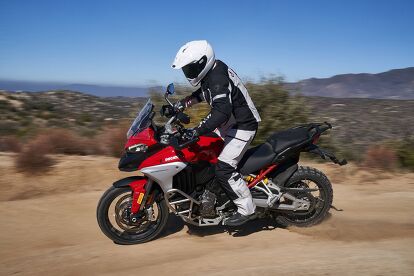
Helmet: Shoei Hornet X2 $595
- Jacket: REV’IT! Sand 4 $500
- Pants: REV’IT! Sand 4 $370
- Gloves: REV’IT! Dominator GTX $300
Boots: Sidi Adventure 2 $450
2021 Ducati Multistrada V4 | |||
|---|---|---|---|
Specifications | Multistrada V4 | Multistrada V4 S | Multistrada V4 S Sport |
| MSRP | $19,995 | $24,095 | $26,095 |
| Engine Type | V4 Granturismo, V4 – 90°, 4 valves per cylinder, counter-rotating crankshaft, Twin Pulse firing order, liquid-cooled | V4 Granturismo, V4 – 90°, 4 valves per cylinder, counter-rotating crankshaft, Twin Pulse firing order, liquid-cooled | V4 Granturismo, V4 – 90°, 4 valves per cylinder, counter-rotating crankshaft, Twin Pulse firing order, liquid-cooled |
| Displacement | 1,158 cc (71 cu in) | 1,158 cc (71 cu in) | 1,158 cc (71 cu in) |
| Bore x Stroke | 83 mm x 53.5 mm | 83 mm x 53.5 mm | 83 mm x 53.5 mm |
| Compression Ratio | 14.0:1 | 14.0:1 | 14.0:1 |
| Power | 170 hp at 10,500 rpm (claimed) | 170 hp at 10,500 rpm (claimed) | 170 hp at 10,500 rpm (claimed) |
| Torque | 92 lb-ft. at 8,750 rpm (claimed) | 92 lb-ft. at 8,750 rpm (claimed) | 92 lb-ft. at 8,750 rpm (claimed) |
| Fuel Injection | Electronic fuel injection system, Ø 46 mm elliptical throttle bodies with Ride-by-Wire system | Electronic fuel injection system, Ø 46 mm elliptical throttle bodies with Ride-by-Wire system | Electronic fuel injection system, Ø 46 mm elliptical throttle bodies with Ride-by-Wire system |
| Exhaust | Stainless steel muffler, double catalytic converter, and 4 lambda probes | Stainless steel muffler, double catalytic converter, and 4 lambda probes | Stainless steel muffler, double catalytic converter, and 4 lambda probes |
| Gearbox | 6 speed | 6 speed | 6 speed |
| Primary Drive | Straight cut gears, ratio 1.8:1 | Straight cut gears, ratio 1.8:1 | Straight cut gears, ratio 1.8:1 |
| Ratio | 1=40/13, 2=36/16, 3=34/19, 4=31/21, 5=23/29, 6=25/27 | 1=40/13, 2=36/16, 3=34/19, 4=31/21, 5=23/29, 6=25/27 | 1=40/13, 2=36/16, 3=34/19, 4=31/21, 5=23/29, 6=25/27 |
| Final Drive | Chain, front sprocket z16, rear sprocket z42 | Chain, front sprocket z16, rear sprocket z42 | Chain, front sprocket z16, rear sprocket z42 |
| Clutch | Multiplate wet clutch with hydraulic control, self-servo action on drive, slipper action on over-run | Multiplate wet clutch with hydraulic control, self-servo action on drive, slipper action on over-run | Multiplate wet clutch with hydraulic control, self-servo action on drive, slipper action on over-run |
| Frame | Aluminum monocoque frame | Aluminum monocoque frame | Aluminum monocoque frame |
| Front Suspension | Ø 50 mm fully adjustable usd fork | Ø 50 mm fully adjustable usd fork, electronic compression and rebound damping adjustment with Ducati Skyhook Suspension | Ø 50 mm fully adjustable usd fork, electronic compression and rebound damping adjustment with Ducati Skyhook Suspension |
| Rear Suspension | Fully adjustable monoshock, Remote spring preload adjustment, aluminum double-sided swingarm | Fully adjustable monoshock, electronic adjustment with Ducati Skyhook Suspension, aluminum double-sided swingarm | Fully adjustable monoshock, electronic adjustment with Ducati Skyhook Suspension, aluminum double-sided swingarm |
| Wheel Travel (Front/Rear) | 6.7 inches / 7.1 inches | 6.7 inches / 7.1 inches | 6.7 inches / 7.1 inches |
| Front Wheel | Light alloy cast, 3″ x 19″ | Light alloy cast, 3″ x 19″ | Light alloy cast, 3″ x 19″ |
| Front Tire | Pirelli Scorpion Trail II 120/70 ZR 19 | Pirelli Scorpion Trail II 120/70 ZR 19 | Pirelli Scorpion Trail II 120/70 ZR 19 |
| Rear Wheel | Light alloy cast, 4.5″ x 17″ | Light alloy cast, 4.5″ x 17″ | Light alloy cast, 4.5″ x 17″ |
| Rear Tire | Pirelli Scorpion Trail II 170/60 ZR 17 | Pirelli Scorpion Trail II 170/60 ZR 17 | Pirelli Scorpion Trail II 170/60 ZR 17 |
| Front Brake | 2 x Ø 320 mm semi-floating discs, radially mounted Brembo monobloc 4-piston 2-pad calipers, radial master cylinder, Cornering ABS | 2 x Ø 330 mm semi-floating discs, radially mounted Brembo Stylema monobloc 4-piston 2-pad calipers, radial master cylinder, Cornering ABS | 2 x Ø 330 mm semi-floating discs, radially mounted Brembo Stylema monobloc 4-piston 2-pad calipers, radial master cylinder, Cornering ABS |
| Rear Brake | Ø 265 mm disc, Brembo 2-piston floating caliper, Cornering ABS | Ø 265 mm disc, Brembo 2-piston floating caliper, Cornering ABS | Ø 265 mm disc, Brembo 2-piston floating caliper, Cornering ABS |
| Instrumentation | 5″ TFT color display | 6.5″ TFT color display with Ducati Connect and full-map navigation system | 6.5″ TFT color display with Ducati Connect and full-map navigation system |
| Dry Weight | 474 pounds (claimed) | 481 pounds (claimed) | 478 pounds (claimed) |
| Kerb Weight | 529 pounds (claimed) | 536 pounds (claimed) | 533 pounds (claimed) |
| Seat Height | Adjustable, 33.1 inches – 33.9 inches | Adjustable, 33.1 inches – 33.9 inches | Adjustable, 33.1 inches – 33.9 inches |
| Wheelbase | 61.7 inches | 61.7 inches | 61.7 inches |
| Rake x Trail | 24.5°/4.0 inches | 24.5°/4.0 inches | 24.5°/4.0 inches |
| Fuel Tank Capacity | 5.8 US gallons | 5.8 US gallons | 5.8 US gallons |
| Number Of Seats | 2 | 2 | 2 |
| Safety Equipment | Riding Modes, Power Modes, ABS Cornering, Ducati Traction Control, Ducati Wheelie Control, Daytime Running Light, Ducati Brake Light | Riding Modes, Power Modes, ABS Cornering, Ducati Traction Control, Ducati Wheelie Control, Daytime Running Light, Ducati Cornering Light, Ducati Brake Light, Vehicle Hold Control | Riding Modes, Power Modes, ABS Cornering, Ducati Traction Control, Ducati Wheelie Control, Daytime Running Light, Ducati Cornering Light, Ducati Brake Light, Vehicle Hold Control |
| Standard Equipment | Backlit handlebar switches, 5″ TFT color display | Ducati Skyhook Suspension, Ducati Quick Shift, Cruise control, Hands-free, Backlit handlebar switches, 6.5″ TFT color display with Ducati Connect and full-map navigation system, Full LED headlight | Ducati Skyhook Suspension, Ducati Quick Shift, Cruise control, Hands-free, Backlit handlebar switches, 6.5″ TFT color display with Ducati Connect and full-map navigation system, Full LED headlight, Carbon fiber front mudguard, Type-approved Akrapovic muffler |
| Warranty | 24 months, unlimited mileage | 24 months, unlimited mileage | 24 months, unlimited mileage |
| Maintenance Service Intervals | 9,000 miles / 24 months | 9,000 miles / 24 months | 9,000 miles / 24 months |
| Desmoservice | 36,000 miles | 36,000 miles | 36,000 miles |

Ryan’s time in the motorcycle industry has revolved around sales and marketing prior to landing a gig at Motorcycle.com. An avid motorcyclist, interested in all shapes, sizes, and colors of motorized two-wheeled vehicles, Ryan brings a young, passionate enthusiasm to the digital pages of MO.
More by Ryan Adams









































































































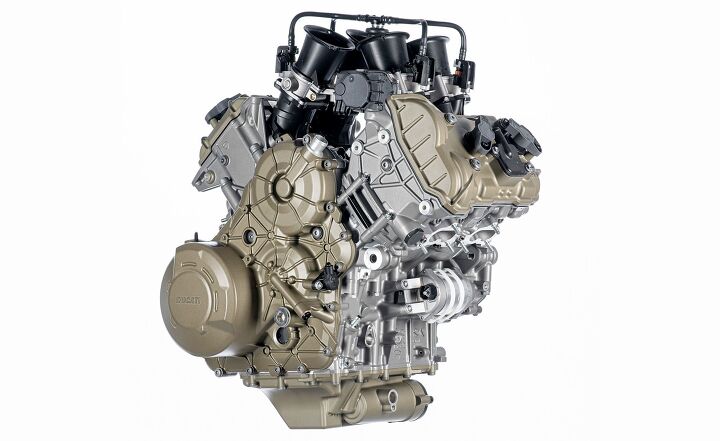



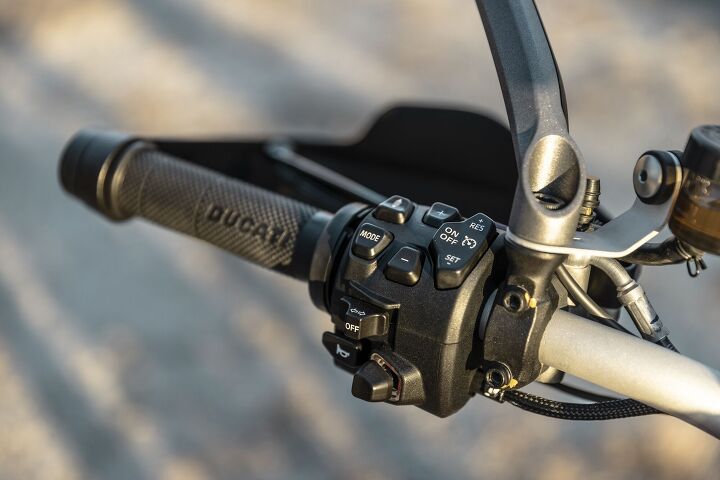








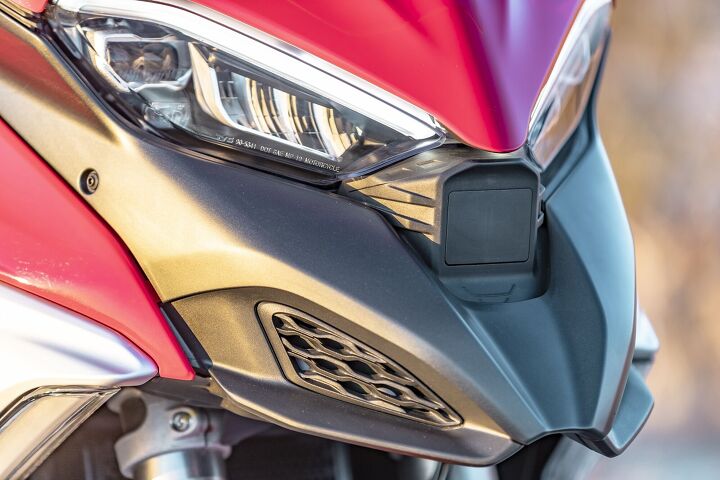























































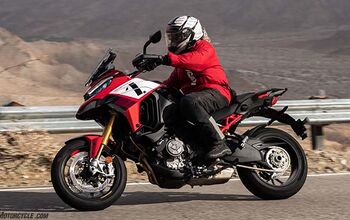
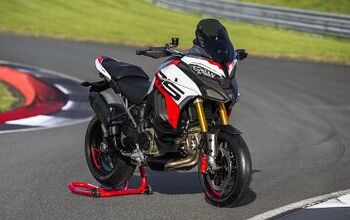










Comments
Join the conversation
angry bird
Impressive - 94.75 What is the highest editor's score of all the bikes reviewed by MO?